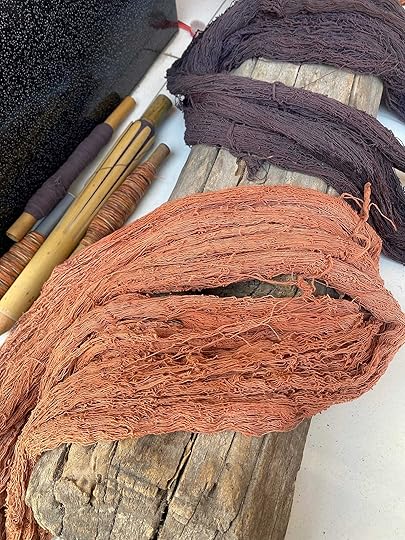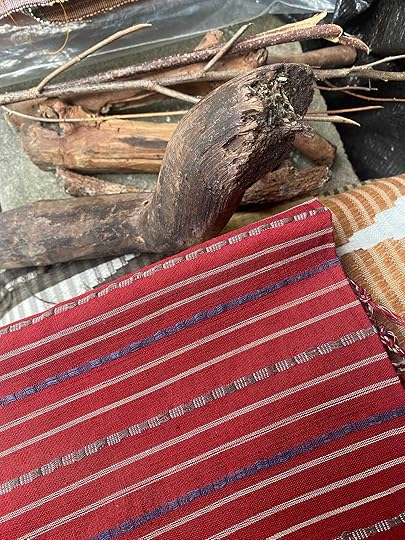Decolonizing Fashion
A vital part of the practice of rewilding fashion is to embrace local knowledge, and empower marginalized communities. Central is the departure from the exploitative, hegemonic systems that tend to dominate the fashion industry. By fostering an environment where local traditions, craft practices, and materials flourish organically, fashion can move beyond the homogenization imposed by globalized, top-down systems.
This shift is a crucial step towards decolonizing fashion, as it offers an approach that allows for indigenous communities and artisans to reclaim their autonomy, elevating their cultural practices in ways that resonate with sustainability, equity, and the potential for transformation.
Fashion shouldn’t be a product to be consumed, but a living practice rooted in culture and environment!
 Naturally dyed yarn, Nisa Penida, Indonesia.
Naturally dyed yarn, Nisa Penida, Indonesia.Rewilding in fashion aligns with decolonial thought by rejecting the notion that indigenous cultures and practices should remain static or are in need of preservation. Drawing from the theories of the previously mentioned book Feral by British biologist and activist George Monbiot, rewilding emphasizes that preservation can sometimes be destructive, stifling the flow of what should naturally evolve.
Rewilding supports development while maintaining ecological balance.
When applied to cultural sustainability, particularly in relation to fashion and garment-creation, this involves respecting the region’s resources, competences, and traditions. However (and importantly!), respect is not the same as preservation. Traditions should not be frozen in time; rather, they should be allowed to flow and evolve, with deep respect for past insights and wisdom. As the saying goes: you cannot step into the same river twice. Everything is always in flux.
There is a somewhat colonial thought in wanting traditional crafts to stay the same — an “Oh, we find it so interesting, so beautiful, and we want it left unchanged so that we can study it and admire it,” as if looking at ancient artifacts behind museum glass.
But living traditions are not meant to be static. To rewild craft traditions is to open them up so that time can flow through them naturally. It means creating the right circumstances for them to develop with integrity and relevance, because static is never natural.
 Traditionally handwoven textile pattern Nusa Penida, Indonesia.
Traditionally handwoven textile pattern Nusa Penida, Indonesia.Empowering artisans through the revival and innovation of traditional practices can open up creative avenues within communities. For instance, teaching weavers how to dye with food waste or explore bacterial dyeing, offers a way to reconnect with local, sustainable materials while fostering creativity. Instead of ready-made fixes, this approach builds capacity: artisans rediscover and reinvent techniques, keeping agency over their craft. As the proverb goes, “Give someone a fish and they’ll eat today; teach them to fish and they’ll eat for a lifetime.”
As fashion becomes more globalized, with production methods and designs homogenized across continents, decolonial practices in fashion grow ever more urgent. These practices challenge the commodification of indigenous cultures and the extraction of cultural capital by outside forces. Instead of being absorbed into globalized trends that erase their histories and identities, marginalized communities can reclaim their cultural narratives through fashion.
The rewilding process helps to center the voices and values of indigenous communities, allowing them to define their own aesthetic futures, not through the lens of colonialism, but as expressions of vitality, creativity, and sustainability.
The rewilding approach to fashion also emphasizes tactile beauty. The tactile experience of materials, the embodied relationship with objects, and the slow, intentional creation of garments can offer a profound means of cultural nourishment. Fashion is not just a visual or consumable object but an experiential, multi-sensory journey. By embracing materials and techniques that honor cultural and environmental connections, fashion can offer aesthetic nourishment of the wearer’s senses, body, and spirit, all while giving the wearer the opportunity to engage with the deeper cultural narratives that these materials represent.
 Weaver in Nusa Penida (Indonesia) showing me one of her beautiful handwoven pieces.
Weaver in Nusa Penida (Indonesia) showing me one of her beautiful handwoven pieces.This shift in fashion is supported by the principle of reciprocity found in e.g. the beautiful book Braiding Sweetgrass, in which American botanist Robin Wall Kimmerer speaks of the relationship between humans and the earth — an exchange in which we should give as much as we take. Rewilding fashion, like rewilding in nature, asks for a relationship with materials and processes that respects the land and communities.
Instead of exploiting natural resources, we can return care and intention to them. And by doing so, fashion is not just a passive process of consumption, but one that is in active dialogue with the earth, allowing both the land and its people to thrive.
Rewilding also offers a framework to challenge the inequalities deeply embedded in the fashion industry — particularly the exploitative labor practices and the extraction of cultural capital from indigenous communities. The colonial structures that have dominated fashion for centuries are built on these inequalities, but the process of rewilding can provide a counterforce: a way to honor and uplift indigenous knowledge and practices in a contemporary context. The opportunities for empowerment are created not by isolating these practices or keeping them in a romanticized past, but by allowing them to evolve, grow, and transform in line with global needs for sustainability and cultural equity.
The practical and philosophical side of rewilding concerns ensuring that what we produce is rooted in a deep respect for the environment, the culture, and the people who create it. This contrasts sharply with the linear, exploitative systems of the dominant fashion industry, which prioritize profit over cultural significance, sustainability, and ethical practices.
The integration of rewilding and decolonial thought into fashion challenges the colonial legacies of cultural appropriation and exploitation. It offers an alternative vision — one where cultural practices, ecological knowledge, and community empowerment are central to the design process. Rewilding fashion moves beyond simply reinterpreting indigenous practices; it creates the space for these practices to evolve into something meaningful for today’s world, without losing their connection to tradition and cultural wisdom.
When rewilding fashion is seen through both aesthetic and ethical lenses, it opens a path toward sustainability, resilience, and deeper meaning. This vision goes beyond mere adornment; it invites everyone who engages with it to actively participate, preserve, and transform.



